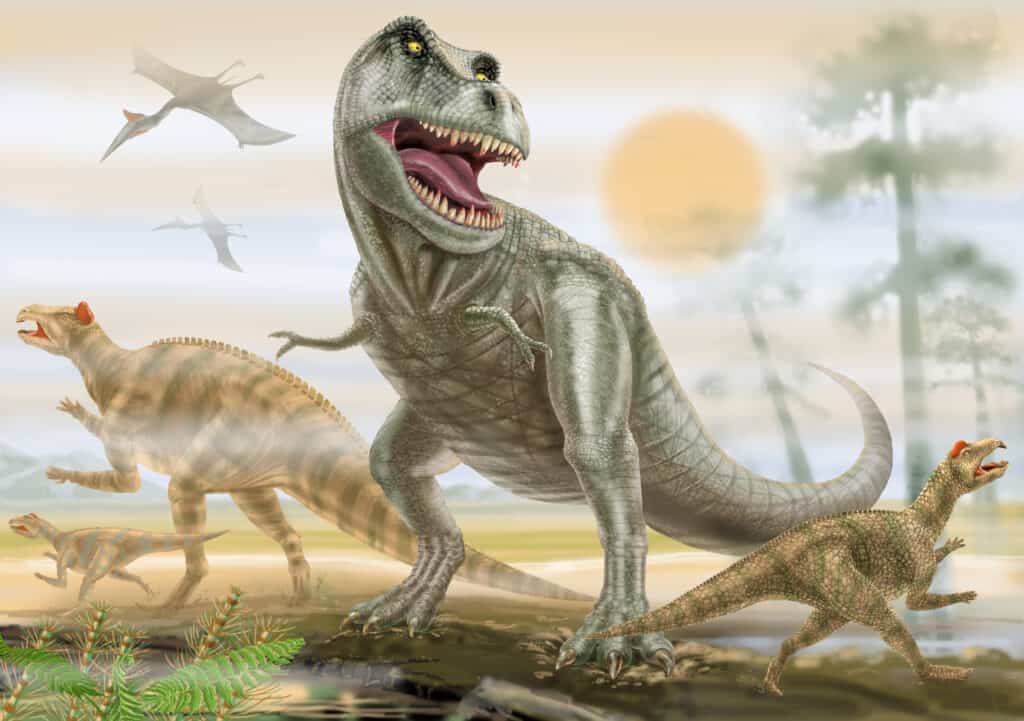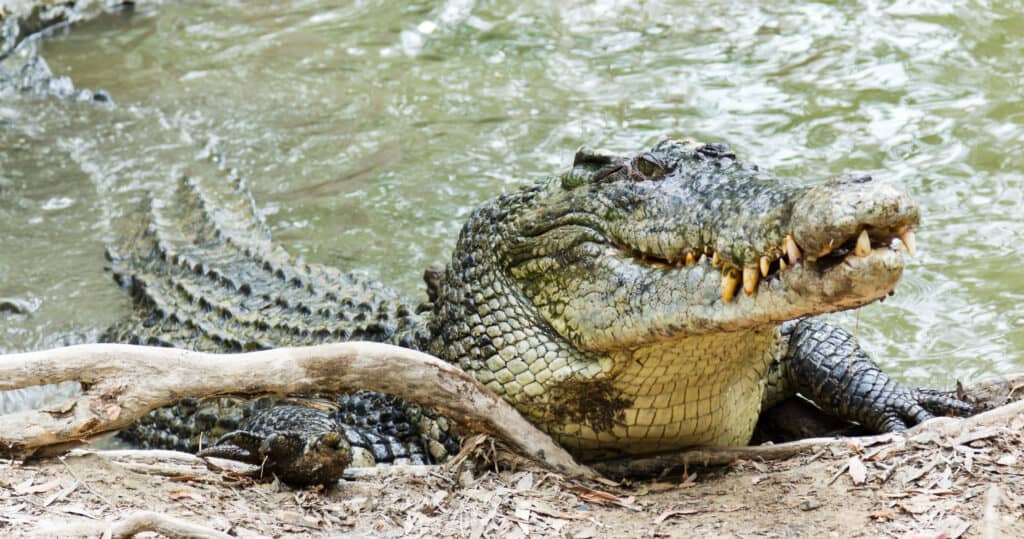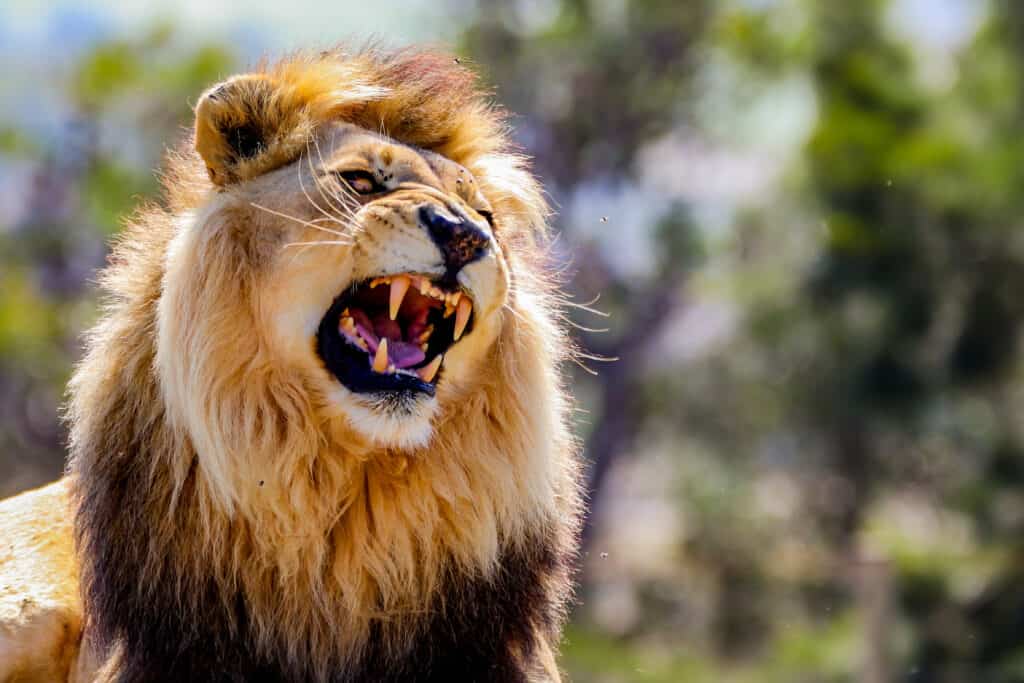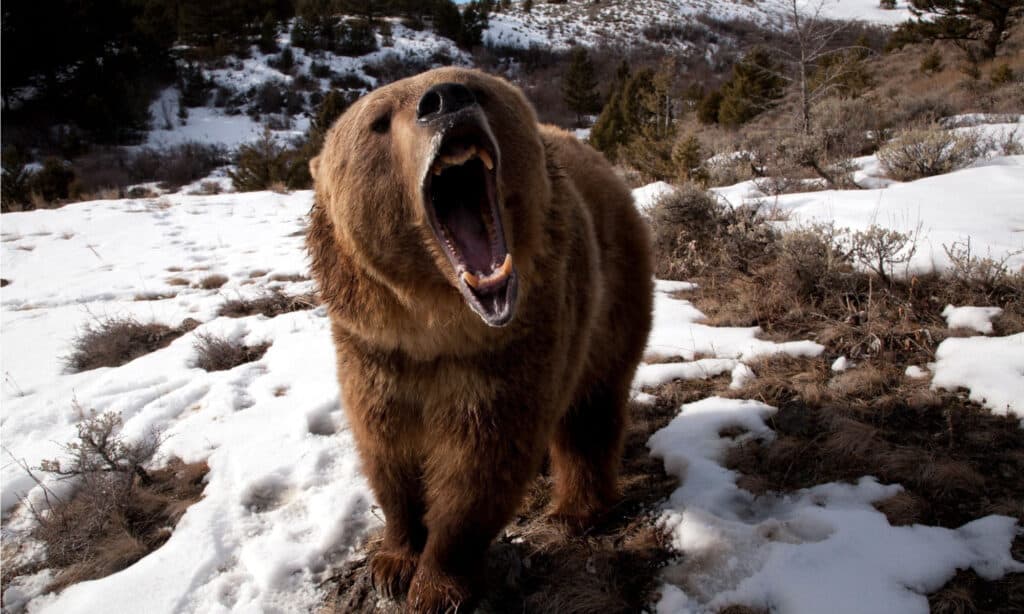T-rex was an immensely powerful dinosaur that roamed North America between 68 and 66 million years ago. Its massive size and bite power allowed it to kill or scavenge a host of other creatures. Although it was successful against other animals in its day, would T-rex still be an apex predator today? We’re going to examine what would happen in a fight between a T-rex vs a lion, grizzly bear, and saltwater crocodile.
We’re going to gather and present the pertinent data to show you what would happen in this battle of a titan vs. some of the toughest predators that are known to the world today.
Comparing a T-rex with a Lion, Grizzly Bear, and Saltwater Crocodile
| T-rex | Lion | |
|---|---|---|
| Size | Weight: from 11,000 to 15,000 pounds Height: stood between 12 and 20 feet Length: could grow up to 40 feet long counting its tail | Weight: between 260 and 550 pounds Height: 3 to 3.9 feet Length: grow about 4.7 to 8.2 feet long |
| Speed | – believed to stride at speeds up to 17 mph | – Capable of reaching 35 mph normally, but they have closing speeds closer to 50 mph |
| Defenses | – Height would protect its vital areas from attacks by many animals – Senses would help it find animals and prevent ambushes – Top speed would let it get away from slower animals – Powerful neck and large head would make it hard to kill without going for internal organs | – Their speed helps them get out of difficult fights – Typically live in groups that help keep them safe – Their large size relative to other large carnivores in their range discourages attacks |
| Offensive Capabilities | – Incredible bite force between 8,000 and 12,800 psi – Once it bites a creature, it’s probably not getting away – Large teeth measuring 12 inches would puncture vital organs and slice meat from the bone – Has up to 60 teeth in its mouth – Speed may have helped with hunting slower or injured prey | – Have fangs that measure almost 4 inches – Most teeth measure about 1 inch – Bite power between 650 and 1,000 psi – Large paws and sharp claws can stagger and gash prey – Typically bite the back or neck of their prey to kill them |
| Predatory Behavior | – Apex predator that probably relied on an opening ambush or surprise tactics – Scavenger | – Ambush predator when hunting alone, but often a cursorial predator when hunting in a group |
| Grizzly Bear | Saltwater Crocodile | |
|---|---|---|
| Size | Weight: from 400 to 700 pounds Height: between 3 and 4.5 feet at their utmost Length: from 7 to 10 feet at their longest | Weight: between 400 and 1,150 pounds, but they can weigh more Length: measure between 10 and 21 feet in length, but larger ones have been found |
| Speed and Movement Type | – Can reach speeds of 35 mph | – May move at 12 and 22 mph on land for very short distances when attacking – May swim at up to 15 to 18 mph |
| Defenses | – Large, thick bodies make it hard for prey to attack – Fur, skin, and fat layer all provide additional protection that makes it hard to land a killing blow – Grizzlies are physically powerful, making it hard to overwhelm them – Their threat display is terrifying to many creatures | – Scutes and scaly body protect it from harm – Thick body makes them hard to bite – Ability to blend into murky water makes them hard to spot – Their speed in water makes them difficult to catch |
| Offensive Capabilities | – Has a powerful bite at 975 psi – Uses a multi-dimensional attack of bites, clawing, smacks, and shaking to vigorously overwhelm their prey – Their teeth measure about 1 inch, with fangs measuring 3 inches – Claws measure between 3 and 5 inches, but they’re not very sharp | – Death rolls can amputate limbs and tear flesh – Powerful 3,700 psi bite – Has 66 teeth that can bite deeply into prey – Typically drag prey into the water to disorient and drown them |
| Predatory Behavior | – Opportunistic predator – More of a scavenger than a predator | – These ambush predators usually wait by the water’s edge to attack animals trying to drink |
What Are 2 Key Differences Between a T-rex and a Lion, Grizzly Bear, and Saltwater Crocodile?
The most significant differences between a T-rex, lion, grizzly bear, and saltwater crocodile are their morphologies and sizes. The T-rex is much larger than all the other animals put together, standing up to 20 feet tall and weighing 15,000 pounds at its utmost. Meanwhile, the other animals combine for less than one-fifth of that measure. Moreover, the T-rex is a medium-sized dinosaur while the grizzly bear and lion are quadrupedal mammals and the saltwater crocodile is a long, reptile with scutes and scales covering its body.
These animals are all very different, and those differences will play a big role in this fight. After all, the unique creatures in this fight have different methods of attack, various ways to defend, and come from mixed environments that could help them thrive in this battle.

(
T-rex) has an incredible bite force between 8,000 and 12,800 psi.
©David Roland/Shutterstock.com
What Are the Key Factors in a Fight Between a T-rex, Lion, Grizzly Bear, and Saltwater Crocodile?
The biggest factors in this fight are going to be the size and offensive capabilities of the animals. For the grizzly bear, saltwater crocodile, and lion, the ability to deal damage to the larger creature is going to be very important to overcoming the T-rex. Moreover, their combined ability to take damage and survive in this fight is also important, and that is where their size comes into play.
However, these are not the only elements that matter in this fight. We have five dimensions to explore. So, we’re going to assign one team or the other a cumulative advantage based on the information that we establish about them.
T-rex vs. Lion, Grizzly Bear, and Saltwater Crocodile Size
The T-rex has a massive size advantage in this battle. The average T-rex weighed between 11,000 and 15,000 pounds, stood up to 20 feet tall, and grew about 40 feet in total length. The other animals combined can’t make up these measures. Lions only weigh about 550 pounds, grizzlies can weigh over 1,000 pounds, and saltwater crocodiles can weigh well over 1,100 pounds in some cases.
Nevertheless, they are facing an absolute monster that is many times their collective size.
The T-rex has a size advantage in this fight.
T-rex vs. Lion, Grizzly Bear, and Saltwater Crocodile: Speed
The T-rex was not necessarily a slow animal, but its speed is low compared to the lion and the grizzly bear. T-rex could move at about 17 mph, but the grizzly and lion can move at 35 mph or higher. The saltwater crocodile is fast in the water, averaging about 15 to 18 mph while swimming.
The lion, grizzly bear, and saltwater crocodile have a speed advantage. The T-rex won’t be able to get away.

The saltwater crocodile is fast in the water, averaging about 15 to 18 mph while swimming.
©Meister Photos/Shutterstock.com
T-rex vs. Lion, Grizzly Bear, and Saltwater Crocodile: Defenses
The T-rex has some helpful defenses that give it an advantage. For one thing, it’s so tall that the lion and crocodile may only attack its legs and possibly its underside if it’s a small one. Its thick body can take a lot of damage before keeling over, and its head and neck, the vulnerable areas that most predators go for, are too thick for a bear, lion, and saltwater croc to get through.
Meanwhile, the lion’s speed would be its best defensive trait in this fight. The same goes for the bear, but its general thickness and size also help. Meanwhile, the saltwater crocodile can always hide in water and make it hard to attack. Still, in a direct conflict, none of this matches up against a T-rex’s power.
The T-rex has a defensive advantage in this fight.

A lion’s speed is its best defense as they are capable of reaching up to 50 mph.
©SteffenTravel/Shutterstock.com
T-rex vs. Lion, Grizzly Bear, and Saltwater Crocodile: Offensive Capabilities
Grizzly bears are effective killers because they use their body weight, claws, paws, and bite to kill their foes. They can deliver vicious bites that puncture several inches deep into their prey. Like grizzly bears, lions use their fangs to bite into the skull and backs of their foes. Meanwhile, the saltwater crocodile has a deadly bite. They latch onto their prey, drag them into the water, and then tear them apart.
None of that is as powerful as a T-rex’s bite. A T-rex’s bite power could be as high as 12,800 psi. If it gets a hold of any of its opponents, they’re going to die. The 12-inch teeth of T-rex would shred their flesh, break their bones, and puncture every vital area.
T-rex has a substantial offensive advantage in this battle.
T-rex vs. Lion, Grizzly Bear, and Saltwater Crocodile: Predatory Behavior
Lions are ambush predators in some cases, and they’re cursorial predators in others. That means they can surprise foes or chase them down and wear them out. Meanwhile, grizzly bears are more likely to scavenge meals and attack prey that they happen to find as opportunists. Saltwater crocodiles attack from the water, using ambush tactics to assault their prey.
T-rex is similar to the grizzly in that it was an opportunist as well as a scavenger. Based on these elements alone, the only creature with a distinct predatory advantage are lions, animals that can end a fight in a moment or continue the battle if that fails.
The lion, grizzly bear, and saltwater crocodile has an advantage in predatory behavior, but not predatory prowess.

Grizzly bears are effective killers because they use their body weight, claws, paws, and bite to kill their foes.
©Falade Adewale/Shutterstock.com
Who Would Win in a Fight Between a T-rex against a Saltwater Crocodile, Grizzly Bear, and a Lion?
A T-rex would win a fight against a lion, grizzly bear, and saltwater crocodile. The T-rex could eat them and still be hungry later on in the same day. Let’s explore the battle anyways. We’re assuming this fight happens near a body of water with ample hiding spots for the lion and grizzly bear to come storming out.
The crocodile could burst out of the water, raring to go. Its first attack would see it biting the T-rex on the foot. The T-rex responds by biting the crocodile, instantly killing. What it doesn’t know is that the saltwater crocodile’s sacrifice was a ruse, allowing the lion and bear to attack. The lion jumps on the T-rex’s side, scratching and clawing its way up the flank. Meanwhile, the grizzly bear stands on two feet and attacks the T-rex’s underside.
The T-rex, obviously bothered by something attacking its underside, turns around suddenly and knocks the bear over before pinning it to the ground. The T-rex can’t reach the lion that has now climbed on its back though. The dinosaur stomps over to a nearby tree, and the lion is forced to abandon its attack before it’s crushed against the vegetation.
The lion, seeing that the tide has turned in the battle, decides to call it a day and runs off. The T-rex may have had trouble catching this animal in the fight, but the lion would never have enough power to do serious damage to a T-rex. Meanwhile, the dinosaur goes back to finish eating the grizzly bear.
Up Next
- T-Rex vs Ankylosaurus: What Are the Differences?
- T-Rex vs Spinosaurus: Who Would Win in a Fight?
- Triceratops vs T-Rex: What Are the Differences?
The photo featured at the top of this post is © Herschel Hoffmeyer/Shutterstock.com
Sources
- ScienceDaily / Accessed November 17, 2022
- ResearchGate / Accessed November 17, 2022
Thank you for reading! Have some feedback for us? Contact the AZ Animals editorial team.







